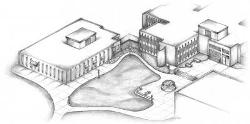Mar 24 2010
A groundbreaking ceremony for a new facility – the Combustion Research Computation and Visualization (CRCV) building, part of the Combustion Research Facility (CRF) – will take place at 2 p.m., Wednesday, March 24, on the grounds of Sandia National Laboratories in Livermore.
 This is an artist's rendering of the Combustion Research Facility complex (right) with proposed Combustion Research Computation and Visualization building (left). The new $5 million building, funded by the Department of Energy's Office of Science and Office of Energy Efficiency and Renewable Energy, will enhance the computational and modeling efforts that are central to the CRF's work portfolio.
This is an artist's rendering of the Combustion Research Facility complex (right) with proposed Combustion Research Computation and Visualization building (left). The new $5 million building, funded by the Department of Energy's Office of Science and Office of Energy Efficiency and Renewable Energy, will enhance the computational and modeling efforts that are central to the CRF's work portfolio.
The Department of Energy's Office of Science (SC) and Office of Energy Efficiency and Renewable Energy (EE) are co-funding the $5 million building, which will enhance the computational and modeling efforts that are central to the CRF's work portfolio.
"Combustion will almost certainly be part of our energy future for decades to come," said Bob Carling, director of Sandia's Transportation Energy Center. "Predictive modeling is a key enabler for the transportation industry, so this new computational facility will be an integral part of our efforts."
The CRCV will offer offices, visualization equipment, collaboration space, and a large room to house high-performance computing clusters. The new facility will enable interdisciplinary collaboration between the combustion scientists and computer scientists needed to address the daunting challenge of understanding combustion, said Carling.
"The building will provide a focal point to further attract leading researchers to develop the methodologies needed to perform and analyze high-fidelity simulations of reacting flows and chemical systems. It will enable wider access to these massive datasets, expand our collaborator base, and enable even greater ties between experimental and computational programs at the CRF and beyond," Carling said.
The CRCV facility will support high-fidelity numerical simulations and the building and testing of models that require highly intensive computational capabilities. First principles direct numerical simulations of turbulent flames, for example, allow for the examination of fine-scale coupling between turbulence and chemistry interactions. Other simulations that will take place in the new facility will include those that allow for the modeling of the entire engine intake and combustion chamber, as well as the smaller scales in the flow that resolve larger scale chemistry issues.
This type of basic research into clean and efficient combustion of current and emerging fuels, said Carling, is a recognized priority for the Office of Science. An Office of Science workshop resulted in a 2007 report, "Basic Research Needs for Clean and Efficient Combustion of 21st Century Transportation Fuels," and highlighted science-based, predictive modeling of the type Sandia researchers are engaged in.
Predictive modeling work continues to grow at the CRF, Carling said, and the space where it currently takes place is crowded and unsatisfactory. "The new building will allow researchers to collaborate much more effectively and will provide the high-end visualization tools that are necessary for this kind of work," he said. Most of the CRF's work, Carling pointed out, is done on an open network and includes interactions with international collaborators.
The new facility is scheduled for completion in October.
Source: http://www.sandia.gov/